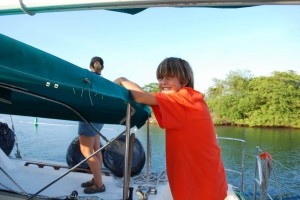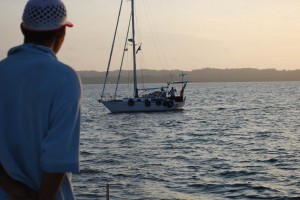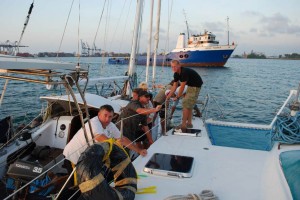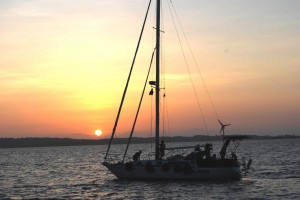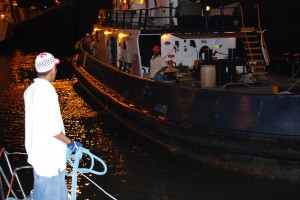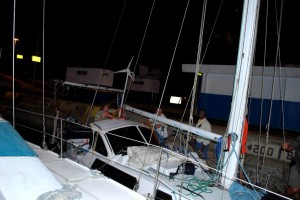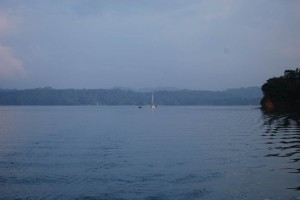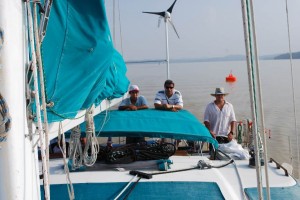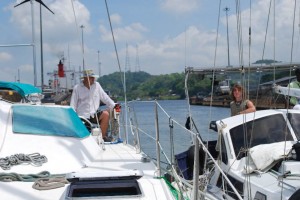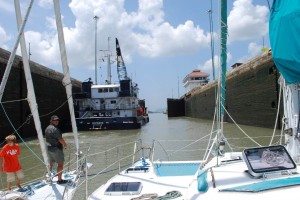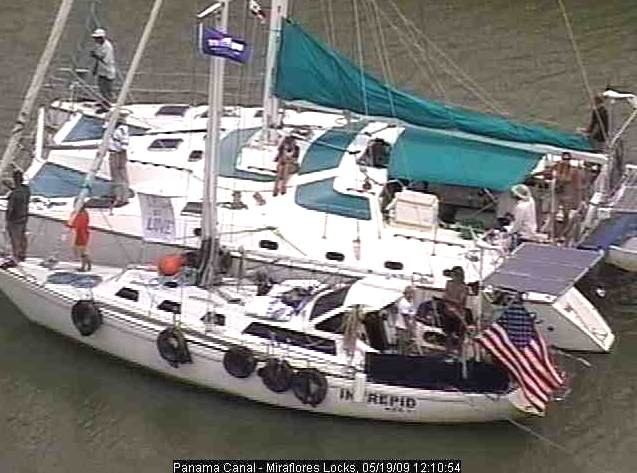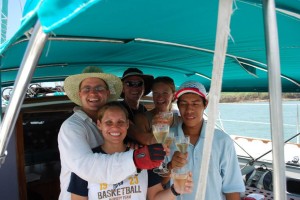Sorry for the late blog update, but we’ve been having a great time ever since we left Shelter Bay. We left the marina just after Intrepid at about 17:30 on Monday to meet so that we would have plenty of time to get to the flats (anchorage area F in Limon Bay) where our advisors were scheduled to board at 18:45. In addition to the four of us, we also had on board Maximo, our Panamanian line handler, Zac’s dad Laurence, Zac’s videographer Brett, Zac’s photographer Jen, and Rosemary with her son David, who are on the beautiful boat Nina at Shelter Bay and were line handlers for Zac. The boat carrying the advisors came fairly quickly after we reached the flats so we transferred Zac’s crew for the transit to his boat and we headed for Gatun Locks, the first set of three chambers that would raise us the approximately 85 feet to the level of Gatun Lake. The advisors are like pilots but for small yachts. They all have a day job and work transits on their day off. Our advisors for both days were great – friendly, knowledgeable, informative, helpful, and even humorous.
Prior to reaching Gatun Locks we rafted up by tying four lines between Pura Vida and Intrepid (one bow, one stern, and two spring lines), with Intrepid on our port side so that our helm station was nearer to Zac’s cockpit to facilitate communication. Zac has a (long) tiller, by the way, instead of a wheel and also has a sizeable hard dodger, so he’s perfected the art of steering under power while standing on the cockpit lazerette (seat/locker) and working the engine throttle with his foot, which is fun to watch. The advisors informed us that we would be going through Gatun Locks tied to an ACP (Panama Canal Authority) tug, which is generally the easiest way to transit.
There was a pretty large ship in the locks ahead of us (I’d guess 600+ feet), then the tug tied up with its starboard side at the edge of the locks. We tied up with Pura Vida’s starboard on the tug’s port side and Intrepid’s starboard on our port side. We found this to be a very easy way to transit. The only adventure came when we unrafted from the tug so that it could move from the first to the second chamber. We hadn’t perfected the art of controlling our rafted boats in tight quarters and the powerful tug took off with enough throttle that we were pushed in to the port chamber wall. Luckily, Zac had plenty of well-placed tires and there was no damage. We discussed rafted motoring techniques while the water was filling the second chamber and the advisors asked the tug to take off a little more slowly, so we had no problems leaving the second and third chambers.
It was dark by time we reached the mooring buoys in Gatun Lake where both boats tied up to the same buoy. Lauren & Tiff had volunteered to provide dinner for everyone Monday night and had cooked two pans of lasagna (mmmmm!!!). They started heating it up as soon as we left the third chamber and plates of warm lasagna, salad, and garlic bread starting coming up from the galley within minutes of both boats being tied up! During dinner, there was a total of 13 people eating aboard Pura Vida with plenty of space for everyone (the Privilege cockpit, one of our favorite features, definitely paid off). The food was delicious and the drinks were flowing with everyone enjoying themselves in conversation. There were many good stories to share as everyone except our line handler has interesting offshore and traveling experience. For example, Brett has circumnavigated twice and spent four and a half years sailing in the South Pacific, so he had lots of good stories and advice for us. When we finally knocked off at almost 2 am, everyone except Zac crashed on Pura Vida (we slept 10 even with both aft bunks full of tools & gear). Wes managed to get in a quick nocturnal dip in the fresh water lake before bed, which is a tradition enjoyed by transiting yachties in spite of the large crocs that inhabit the area.
We were expecting to be awakened by the howler monkeys, which make the most amazing beast-like growls/yells in the morning, but at ten till six in the morning, Laurence & Brett, who were sleeping the the tramps, hollered down below that the pilot boat was nearing us. That was a little earlier than expected, but we crawled out of our bunks and were underway shortly after 6 am. Pura Vida had new advisor, Lorenzo, who was great, and Intrepid actually had the rare experience of getting the same advisor for the second day. He joked that he had come back to return our fork, which we’d sent with him when the boat to pick up the advisors the night before had arrived before he’d had a chance to finish his dinner.
Most of the second day transiting the canal is pretty boring when you’re doing it for the second time as Wes and I were, although it’s still exciting to do it in your own boat. David taught us a new card game called Bob on the way while we moored at Gamboa waiting for Intrepid to close the distance between us. While at Gamboa, Lorenzo pointed out a massive crane at the ACP facility. He explained that the US had taken it from Germany after World War II as part of “the price of war” and brought it to Panama where it was later sold to the Panamanians for something like $1. Although it looks too big for the task, the floating crane is moved into the locks to service the chamber gates. It lifts the hollow gates, when are then filled with air and sealed. Once the gates are sealed, they are floated on the water and are pushed by tug to Colon for service. As the ACP doesn’t have any extra gates, the whole operation must be done very efficiently to minimize the down time for one of the two canal lanes.
After motoring through Gatun Lake and the Culebra cut with Wes at the wheel we came to the Pedro Miguel Lock (one down-chamber) at about 11:30. This time we were in the chamber with only a relatively small ACP powered crane barge, so we were nested center-chamber in a short chamber — intermediate chamber gates were used that made it smaller than the standard 1000ft x 110ft. We stayed rafted up with Intrepid to motor the short distance to the Miraflores Locks with its two down-chambers that would bring us into the Pacific. The down locks are usually a relatively boring affair after the up locks, but they were made a bit more interesting for us because we were handling our own lines for the first time. Also, there were several camera crews and photographers at the Miraflores Locks to cover Zac’s transit. The canal is truly an amazing feat of engineering and construction. It’s difficult to imagine the landscape before the Chagres River basin was dammed & flooded, the locks moving millions of gallons of water for each transit without pumps (just gravity), and the canal operating since it opened without any stoppages (of both lanes).
We handed Zac one of our air horns to blow when the last set of gates opened and it was our turn to motor out of the locks and into the Pacific. The red and green channel markers were now on the opposite side of the channel as we made the traditional champagne toast associated with transiting between the oceans.
After the advisors disembarked, we headed for a mooring at Balboa Yacht Club and Intrepid headed for Flamenco Marina. We had just tied up on our mooring at the edge of the mooring field when Intrepid passed us on the way to Flamenco. All in all, a pretty good day. Our engines carried us all the way across the Canal with no problems, and we are finally in the Pacific. The skyline of Panama City, with its 3+ million inhabitants was quite a change after being buried in the jungle at Shelter Bay. The area we’re moored at was formerly part of the Canal Zone and is now primarily a tourist area, so after dinner at the Yacht Club, Lauren and I were able to enjoy a nice walk of a couple miles or so down the causeway to the group of three islands at the end where there are numerous stores and shops, two anchorages, and Flamenco Marina. After all of that, we were confident that we would sleep well despite the very large container ships passing by our mooring on their way to the Canal.


